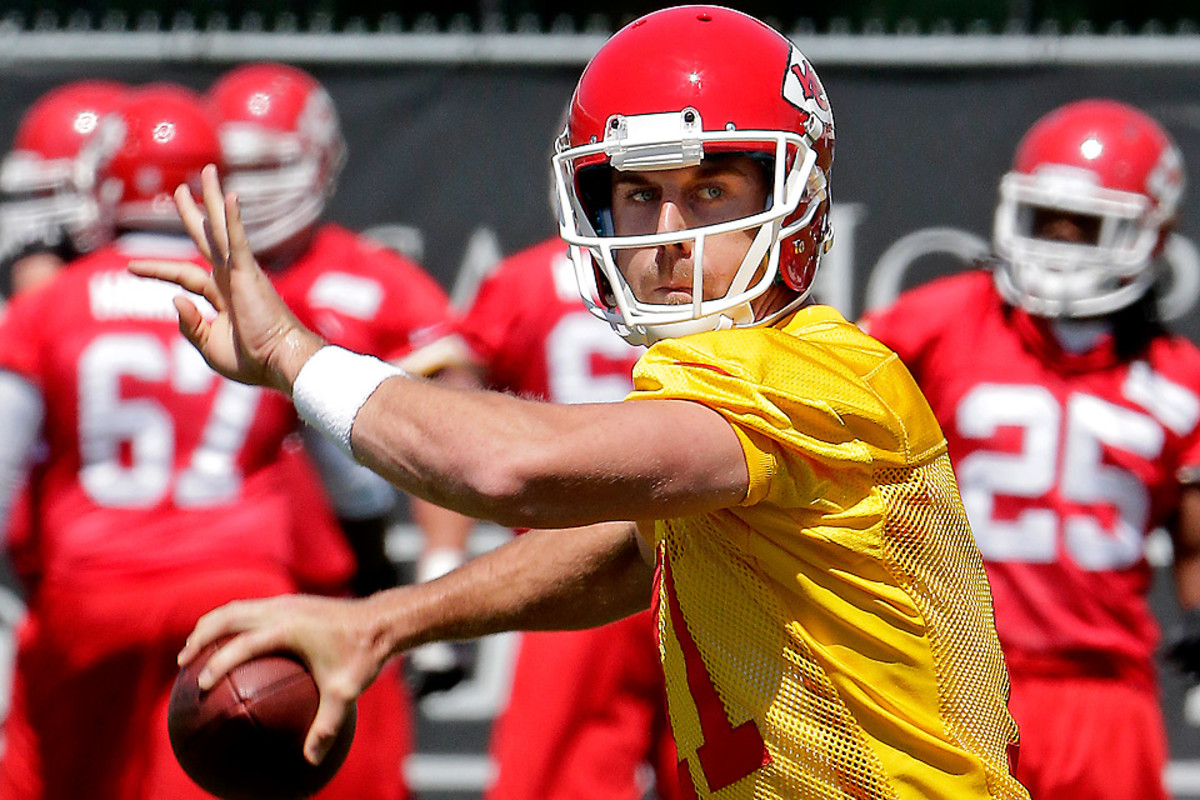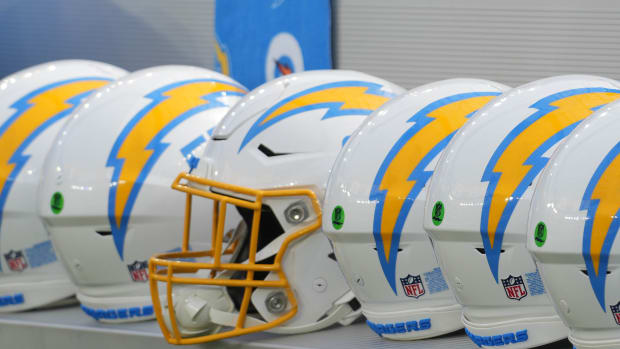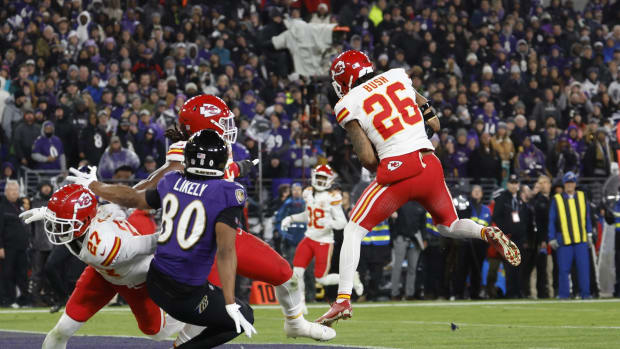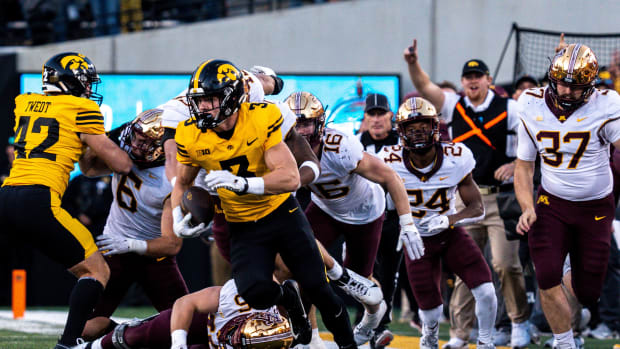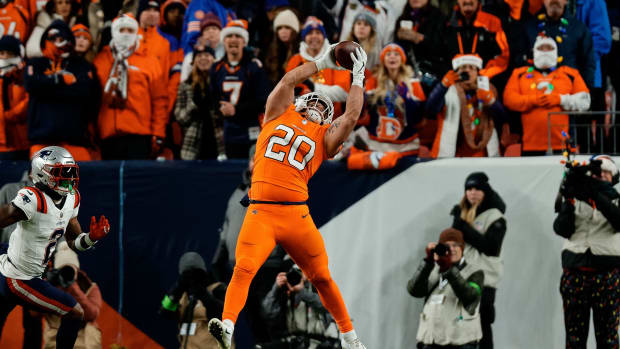Chiefs Preview: Curb Your Enthusiasm
In the 43 years since the AFL-NFL merger, four teams have won at least 10 games the season after posting the league’s worst record: the 1975 Colts, the 2004 Chargers, the 2008 Dolphins and the 2012 Colts. It may be another 43 years before we see a team as well positioned for that kind of turnaround as the 2013 Chiefs. Like 11 of the last 16 clubs that have drafted first overall, the Chiefs enter this season with a new head coach (Andy Reid). Like 10 of those 16, they have a new quarterback (Alex Smith). For good measure, there’s also a new general manager (former Packers director of college scouting John Dorsey).
But the optimism in Kansas City does not stem as much from the changes in leadership, but rather from what this team already was. The 2012 Chiefs may have been the best 2-14 team in NFL history—and that’s not being facetious. Recall that two years before 2012, virtually the same club won the AFC West.
The Chiefs’ 2012 face-plant was the result of atrocious quarterback play and a minus-24 turnover ratio, which tied for the second-worst differential the NFL has seen in 22 years (the 2000 Chargers were minus-28). A disproportionate chunk of Kansas City’s 37 turnovers—16, to be exact—came inside its own 30-yard line. (For some comparison, the Colts, who led all AFC playoff teams with 20 total turnovers, lost the ball just twice inside their own 30.) This partly explains why the Chiefs did not play with a lead for even one second in the first nine weeks of the season.
Ironically, the other team that had a minus-24 turnover differential last year was Reid’s Eagles. But that was an aberration: Reid has always been a pass-happy play-caller, but his teams have never been known for carelessness. Turnovers shouldn’t be an expected problem for the Chiefs. For one thing, turnovers—particularly fumbles—involve a lot of random chance, which is why they’re statistically flaky from year to year. For another, new quarterback Alex Smith’s main strength is ball security.
Of course, that’s also illustrative of Smith’s mediocrity. (Tom Brady and Aaron Rodgers don’t throw many interceptions, but no one would ever cite “ball security” as their top attribute.) This is why eyebrows raised when it was announced that Kansas City had traded the 34th overall pick in last April's draft to acquire Smith back in March.
As the Niners showed, you can win with Smith at the helm. But to do so, you must be great in just about every other area.
OFFENSE
To have any shot at being genuinely competitive, Jamaal Charles must be the featured weapon. Coming off ACL surgery, Charles last season showed his usual unparalleled speed and lateral agility, leading the AFC with 1,509 yards rushing. His career 5.8 yards per carry is more than a half-yard better than previous all-time leader Jim Brown (minimum 750 carries).
Reid, who will call plays while first-year coordinator Doug Pederson learns the ropes, hasn’t always been big on running the ball. Charles, a so-so receiver, can get additional touches on screen passes, which are a staple in this West Coast system. Charles should also have little trouble getting into space on straight handoffs. Not only does he have speed and acceleration around the corner, but he’s also playing in a system full of zone-blocking schemes that attack the perimeter. In Philly, Reid had a similarly agile back in LeSean McCoy; a staggering 146 of McCoy’s 200 carries last season went wide outside.
Kansas City’s offensive line has the athleticism for wide run-blocking. The interior is average with steady-but-unspectacular Jon Asamoah at right guard, rotund center Rodney Hudson back from the broken leg that landed him on IR last September and unimpressive 2012 second-rounder Jeff Allen hoping to fend off veteran pickup Geoff Schwartz at left guard. Collectively, though, these men can move well enough to keep up with the outstandingly athletic bookend tackles.
In his three full seasons as a starter, Jamaal Charles has averaged an amazing 5.9, 6.4 and 5.3 yards per carry. (Jamie Squire/Getty Images)
The addition of No. 1 overall pick Eric Fisher could add ranginess to both tackle spots—with Fisher assuming the job on the left side, Branden Albert will move over to the right. (The Chiefs have initially kept Albert at left tackle and used the rookie on the right, but we’ll see if that arrangement holds up.) By traditional standards Albert is probably overqualified to play right tackle. But the league-wide rise of hybrid defensive packages has reduced the importance of distinguishing between left and right tackles. Coaches build their blocking schemes around helping one side in pass protection, but they don’t care which side (especially since the now-ubiquitous shotgun alignment leaves the quarterback without a “blind side”).
The Chiefs may not have to help either side in pass protection. Nice as that is, it’s not significant enough to justify drafting a tackle first overall. Fisher might turn out to be sensational, but with more spread concepts and quicker pass timing throughout the NFL, there’s no way he (or any offensive lineman) can resoundingly impact a game. Unless left outside runs become Kansas City’s overwhelmingly preferred method of attack (they won’t, because that’d be too predictable), this offense won’t be radically different with Fisher at left tackle than it would have been with the heavier-footed-but-serviceable Donald Stephenson.
If the Chiefs really wanted to ignite their offense, they would have spent the No. 1 pick on a unique game-changer like Tavon Austin. Of course, that type of player can sometimes become a positionless, rudderless Dexter McCluster-type—that might be too great a risk to take with the first overall pick. Then again, isn’t it risky trying to win with a bland passing attack?
The Chiefs are hoping that Dwayne Bowe can give their passing attack enough flavor. The seventh-year pro’s numbers dropped last season—59 catches, 801 yards, three touchdowns—but Dorsey and Reid recognized the decline was mostly a product of shoddy quarterback play. Bowe does not have the speed and quickness to command constant double teams, but he’s a firm interior possession target capable of getting over the top. He needs more help around him, though. Former 2011 first-round pick Jon Baldwin remains far too unpolished and perplexingly sluggish as a route runner.
If Baldwin doesn’t make a quantum leap, new No. 3 receiver Donnie Avery could wind up being the No. 2. Or, it could be last year’s fourth-round pick, Devon Wylie, given that the fast-footed Avery has struggled with injuries and drops over the years. Wylie played only 80 snaps in 2012 but looked like a potential Lance Moore type.
Even though the Chiefs traded for fullback Anthony Sherman and drafted another fullback, sixth-rounder Braden Wilson, as well as 227-pound third-round back Knile Davis (who will compete with incumbent backup Shaun Draughn), multiple tight ends could figure prominently in the offense’s foundational sets. The formation versatility of San Francisco’s dual tight end sets helped Alex Smith by keeping defenses in base looks. Veteran Anthony Fasano was brought in to start alongside incumbent Tony Moeaki, who is looking to regain the on-the-move run-blocking and seam route-running skills that he had prior to tearing his ACL in 2011. Fasano isn’t versatile enough to split out wide, and he’s adequate but not sensational as a solo blocker. He can still be a fine puzzle piece, but the Chiefs are likely yearning for third-round rookie Travis Kelce to develop quickly. But “quickly” could mean “two years” given that Kelce didn’t see significant playing time until his senior year at Cincinnati.
As for Smith, Arrowhead patrons will be tempted to think the 29-year-old can suddenly be a star. But if he could, he’d be one by now. Smith can be better than Matt Cassel, but there are limitations in his game. He’s a smart person but doesn’t have a quick enough football mind to be a progression passer from the pocket. That’s why 49ers coaches almost exclusively called one- or two-read pass plays with him. Smith’s athleticism is good, not great, and his arm strength is at least a full notch below that. Nevertheless, Smith’s patience and discipline as a game-manager gives this offense a chance to at least be competitive.
DEFENSE
Reid always ran a 4-3 in Philadelphia, but he has smartly decided to keep predecessor Romeo Crennel’s 3-4 foundation intact in K.C. Despite the Chiefs’ propensity last year for giving up big plays (46 over 25 yards, tied for the most in the AFC), a 3-4 is indisputably the best scheme for its talented core players. Reid hired former Jets linebackers coach Bob Sutton to coordinate things. Sutton is well-versed in a variety of schemes; during his 13-year tenure in New York, he coached a 4-3 Tampa-2 under Herm Edwards, a traditional two-gap 3-4 under Eric Mangini and an attacking hybrid under Rex Ryan. He could diversify some of the Chiefs’ sub-packages.
Sutton has the ultimate centerpiece to build around in veteran Derrick Johnson, the versatile ninth-year linebacker who is coming off a third consecutive career-year. His sensational fluidity in space is complemented by his increasingly keen play recognition. He takes great angles in run defense, blitzes with controlled ferocity and has a sharp sense for finding receivers and passing lanes. Best of all, his once overly-finesse style of play has been fortified by a newfound appetite for physicality.
But as shown by Kansas City’s 135.7 rushing yards allowed per game last year (sixth most in the NFL), Johnson can’t carry the front seven alone. There must be stauncher gap control along the D-line, and the Chiefs have the resources. Athletic nose tackle Dontari Poe, who has light feet and plays with natural leverage, improved rapidly as a rookie. It will be at least another year or two before the first-rounder fully ripens, but with Jerrell Powe and Anthony Toribio providing quality depth, that’s fine.
Defensive end Tyson Jackson is a finished product given he has four seasons under his belt. With iffy initial quickness, Jackson hasn’t had the impact one would expect from a former No. 3 pick, but he can be a respectable run defender. On the other side, ex-Jet Mike DeVito will be an upgrade over another underachieving high first-rounder, Glenn Dorsey (now a Niner). DeVito is a high-octane, low-to-the-ground penetrator who can disrupt multiple gaps. He also anchors well against the run, which is why he’ll start ahead of incumbent sub-package defensive lineman Allen Bailey, who has not stood out when given full-time snaps.
Justin Houston broke out last season, to the tune of 10 sacks in his second year. (Jamie Squire/Getty Images)
Last season, according to Football Outsiders, 48.3 of the Chiefs’ 135.7 rushing yards surrendered each week came against dime personnel. The Chiefs played dime instead of nickel because the coaches did not believe any of their inside linebackers other than Johnson could survive in coverage. When offenses went three-wide, the Chiefs’ D went three safeties, with Eric Berry in the box. Whether the new coaches follow this approach will depend on how they view new inside backers Zac Diles and Akeem Jordan. Diles flashed early in his career but never fully blossomed. Jordan, who played for Reid in Philly, is inconsistent but has some athleticism.
Playing Berry in the box again would not be the worst thing—he is physical and has a hunter’s mindset. His primary focus must be on improving in coverage. Berry was a liability in man-to-man much of last season and often showed poor peripheral awareness in zone. To his credit he got better toward the end of the year, but he still has a way to go to fulfill his star potential.
Joining Berry in centerfield will be Kendrick Lewis, a mundane fourth-year pro. It’s possible fifth-round rookie Sanders Commings could compete here, though he played cornerback in college and broke his collarbone on the first day of training camp. Quintin Demps could push for playing time, though he was a mistake machine with the Texans last year. A more attractive option might be nickelback Dunta Robinson, who is comfortable making reads in space. The main concern would be whether Robinson is a strong enough tackler to serve as the last line of defense. He’s a good hitter, but delivering hits and making firm tackles are two different things.
Atlanta cut Robinson in part because he’s not a great pure man defender. That could complicate Sutton’s sub-package coverages because the corners on the outside are built to play press-man. Brandon Flowers is one of the best boundary defenders in the league. He uses his size extremely well downfield and rarely gets challenged because his man rarely gets open. Newcomer Sean Smith is a strong, lanky athlete. However, he must get sharper against outside comeback routes from off-coverage. If he doesn’t, Robinson could start ahead of him.
The bottom of the cornerback depth includes Commings, who was strictly a boundary corner at Georgia, and Jalil Brown, who was a vulnerability while playing 23 snaps per game last season. This means the Chiefs are dangerously dependent on Robinson, as he’s their only viable option for the slot.
If Sutton adopts a lot of the tactics he learned under Rex Ryan, Kansas City’s interior defensive backs will have to get familiar with blitzing. But that may not be mandatory, as Sutton has what Ryan never had in New York: dynamic edge-rushing linebackers. Tenacious eighth-year pro Tamba Hali is as good as anyone when it comes to dipping blocks and generating pursuit off second effort. Sinewy third-year pro Justin Houston seems to become a more refined pass rusher by the minute. He and Hali, however, are not good at dropping into coverage, which could discourage Sutton from borrowing many of Ryan’s zone blitz concepts. Hali and Houston also aren’t helped much by the guys around them. Last season the pair combined for 19 sacks, while the rest of the defense had eight. (Kansas City’s 27 total sacks tied for 29th in the league.)
SPECIAL TEAMS
Kicker Ryan Succop has good range but needs to be a little more consistent at the intermediate levels; he’s 35-for-46 (76.1%) on field goals from 30-49 yards over the last two years. Ninth-year punter Dustin Colquitt is coming off his first Pro Bowl. With Javier Arenas getting traded to Arizona, the return duties are up for grabs. Shaun Draughn can handle kicks; punts will be determined in camp.
BOTTOM LINE
The Chiefs have a potentially dynamic run game and a potentially dynamic defense. That makes them a potential Wild Card contender (but that’s a best case scenario).
Andy Benoit is diving deep into each team's prospects for 2013. Read what he's done so far.
































